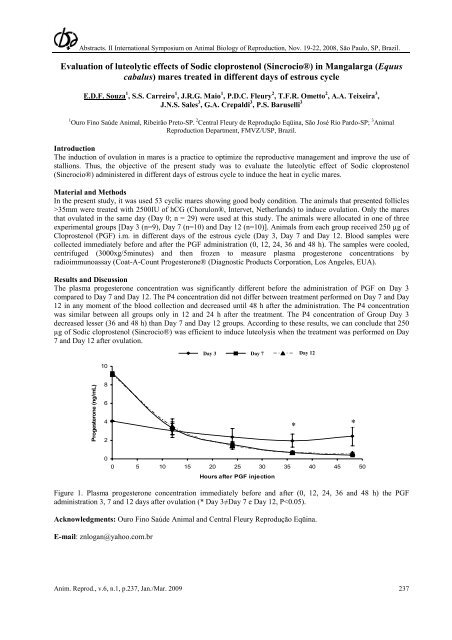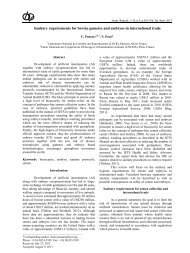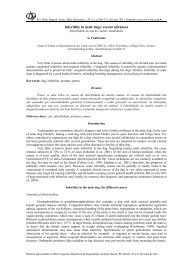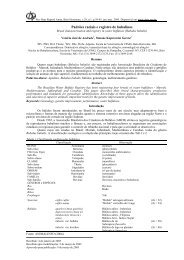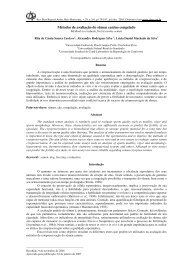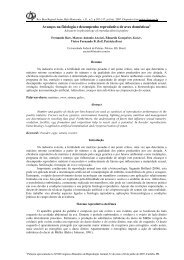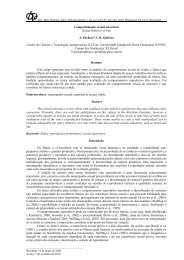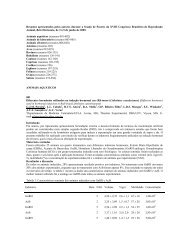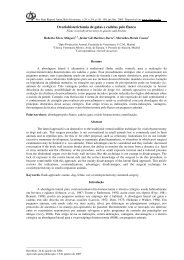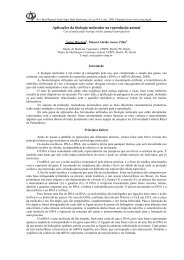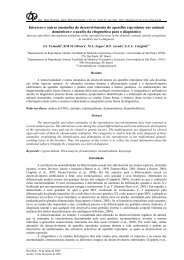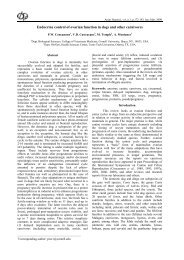Recent advances in ovulation synchronization and superovulation in ...
Recent advances in ovulation synchronization and superovulation in ...
Recent advances in ovulation synchronization and superovulation in ...
You also want an ePaper? Increase the reach of your titles
YUMPU automatically turns print PDFs into web optimized ePapers that Google loves.
Abstracts. II International Symposium on Animal Biology of Reproduction, Nov. 19-22, 2008, São Paulo, SP, Brazil.<br />
Evaluation of luteolytic effects of Sodic cloprostenol (S<strong>in</strong>crocio®) <strong>in</strong> Mangalarga (Equus<br />
cabalus) mares treated <strong>in</strong> different days of estrous cycle<br />
E.D.F. Souza 1 , S.S. Carreiro 1 , J.R.G. Maio 1 , P.D.C. Fleury 2 , T.F.R. Ometto 2 , A.A. Teixeira 3 ,<br />
J.N.S. Sales 3 , G.A. Crepaldi 3 , P.S. Baruselli 3<br />
1 Ouro F<strong>in</strong>o Saúde Animal, Ribeirão Preto-SP. 2 Central Fleury de Reprodução Eqü<strong>in</strong>a, São José Rio Pardo-SP; 3 Animal<br />
Reproduction Department, FMVZ/USP, Brazil.<br />
Introduction<br />
The <strong>in</strong>duction of <strong>ovulation</strong> <strong>in</strong> mares is a practice to optimize the reproductive management <strong>and</strong> improve the use of<br />
stallions. Thus, the objective of the present study was to evaluate the luteolytic effect of Sodic cloprostenol<br />
(S<strong>in</strong>crocio®) adm<strong>in</strong>istered <strong>in</strong> different days of estrous cycle to <strong>in</strong>duce the heat <strong>in</strong> cyclic mares.<br />
Material <strong>and</strong> Methods<br />
In the present study, it was used 53 cyclic mares show<strong>in</strong>g good body condition. The animals that presented follicles<br />
>35mm were treated with 2500IU of hCG (Chorulon®, Intervet, Netherl<strong>and</strong>s) to <strong>in</strong>duce <strong>ovulation</strong>. Only the mares<br />
that ovulated <strong>in</strong> the same day (Day 0; n = 29) were used at this study. The animals were allocated <strong>in</strong> one of three<br />
experimental groups [Day 3 (n=9), Day 7 (n=10) <strong>and</strong> Day 12 (n=10)]. Animals from each group received 250 µg of<br />
Cloprostenol (PGF) i.m. <strong>in</strong> different days of the estrous cycle (Day 3, Day 7 <strong>and</strong> Day 12. Blood samples were<br />
collected immediately before <strong>and</strong> after the PGF adm<strong>in</strong>istration (0, 12, 24, 36 <strong>and</strong> 48 h). The samples were cooled,<br />
centrifuged (3000xg/5m<strong>in</strong>utes) <strong>and</strong> then frozen to measure plasma progesterone concentrations by<br />
radioimmunoassay (Coat-A-Count Progesterone® (Diagnostic Products Corporation, Los Angeles, EUA).<br />
Results <strong>and</strong> Discussion<br />
The plasma progesterone concentration was significantly different before the adm<strong>in</strong>istration of PGF on Day 3<br />
compared to Day 7 <strong>and</strong> Day 12. The P4 concentration did not differ between treatment performed on Day 7 <strong>and</strong> Day<br />
12 <strong>in</strong> any moment of the blood collection <strong>and</strong> decreased until 48 h after the adm<strong>in</strong>istration. The P4 concentration<br />
was similar between all groups only <strong>in</strong> 12 <strong>and</strong> 24 h after the treatment. The P4 concentration of Group Day 3<br />
decreased lesser (36 <strong>and</strong> 48 h) than Day 7 <strong>and</strong> Day 12 groups. Accord<strong>in</strong>g to these results, we can conclude that 250<br />
µg of Sodic cloprostenol (S<strong>in</strong>crocio®) was efficient to <strong>in</strong>duce luteolysis when the treatment was performed on Day<br />
7 <strong>and</strong> Day 12 after <strong>ovulation</strong>.<br />
Progesterone (ng/mL)<br />
10<br />
Figure 1. Plasma progesterone concentration immediately before <strong>and</strong> after (0, 12, 24, 36 <strong>and</strong> 48 h) the PGF<br />
adm<strong>in</strong>istration 3, 7 <strong>and</strong> 12 days after <strong>ovulation</strong> (* Day 3≠Day 7 e Day 12, P


